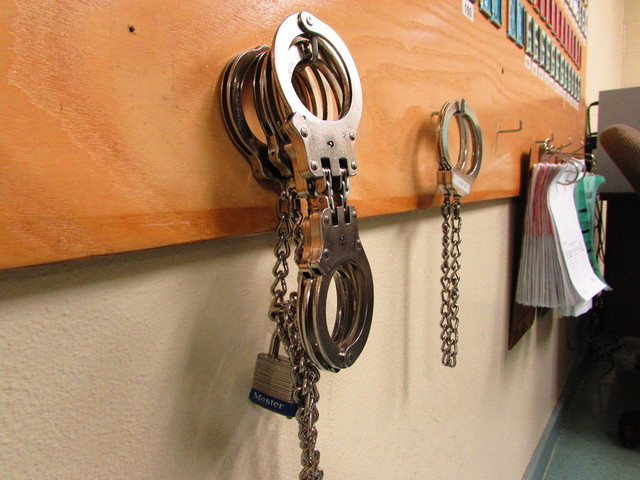Think of segregation as a prison within a prison, meant to punish and deter bad behavior.
Inmates in segregation spend most of their time in their cells. They’re often restrained in handcuffs and leg chains. They have to submit to constant strip searches for weapons and drugs. Family visits are restricted. They don’t get to make phone calls.
“Every time they walk out of their cell, they’re in restraints,” says Lt. Stephan Riley, a spokesman at the California State Prison, Sacramento, a maximum-security prison that includes a variety of segregation units, some with greater restrictions than others. On average, an inmate in segregation spends about 90 percent of his time inside a small cell, essentially a concrete box with a slat of a window. Ten hours a week is exercise in a small yard surrounded by a chain-link fence.
The prison does offer psychiatric services, including group therapy. But group therapy for inmates in segregation looks far different from group therapy outside: Guards lock the inmates into metal holding cells the size of telephone booths, called therapeutic modules.
“There’s a metal mesh that’s welded to the frame of the module, and that’s the barrier,” explains Dr. David Wheeler, acting chief of mental health. He says the prison requires that barrier between his staff and any inmates they treat who are in segregation, whenever custody officers are out of the room.
For confidential one-on-one sessions, inmates sit in a locked booth with a window that faces a clinician, who is also in a locked booth.
But so much time alone is damaging to those with mental illness, advocates say.
Isolated and idle
“The person in the segregation cell is almost entirely isolated and idle,” says psychiatrist Terry Kupers, “and those two states are the worst thing you can do to someone with a mental illness.”
Kupers, a national expert on correctional mental health care, quickly lists the effects segregation units can have on inmate patients. “High anxiety, which may take the form of panic; disordered thinking, which may become paranoid; mounting anger; problems concentrating; problems with memory; compulsive activity like cleaning their cell many times a day or pacing relentlessly."
Kupers says segregation worsens mental illness and makes those illnesses less treatable long term.
A court-appointed federal monitor for mental health care found that nearly half of 32 suicides in California prisons in 2012 were committed in segregation units. Nearly all of those prisoners were receiving mental health services at the time. In 2013, nearly half the 28 suicides occurred in segregation.
New restrictions on use of segregation
U.S. District Judge Lawrence Karlton appointed a special master for mental health care 20 years ago when advocates for inmates first sued the state over shoddy treatment.
In April, Karlton found that the high rate of suicides is evidence that segregation poses serious risk to mentally ill inmates:
“The overwhelming weight of evidence in the record is that placement of seriously mentally ill inmates in California’s segregation housing units can and does cause serious psychological harm, including decompensation, exacerbation of mental illness, inducement of psychosis and increased risk of suicide.”
Karlton imposed a series of hurdles that prisons have to clear before they can put any mentally ill inmate into a segregation unit.
Officials with the California Department of Corrections and Rehabilitation declined to comment for this story, citing “sensitive” negotiations on the details of how to comply with Judge Karlton’s order.
But Michael Bien, the lead attorney for mentally ill inmates says Karlton’s latest ruling ends a vicious cycle for inmates in the most severe segregated housing known as Security Housing Units (SHUs).
“Someone is in one of these segregation units. They get very sick,” Bien says. “(Prison officials) hospitalize them; they stabilize them, but they send them back -- now to a mental health segregation unit. They get sick again, they send them back to the hospital -- that cycle -- we think the judge has ended.”
Judge Karlton forbade prison officials to send such an inmate back to the segregation unit where he or she deteriorated.
Judge Karlton also said an inmate’s psychiatrist must certify that the action for which the inmate is being segregated wasn’t the result of a mental illness and that there’s no clinical indication that segregation will worsen the inmate’s condition.
Bien says prison officials will have to come up with safer alternatives for people who can’t tolerate segregation, and says a start would be giving mental health staff more say over how inmates with mental illness are treated.
“You can turn a unit into a less dangerous place,” says Bien, “if you give power to clinicians to say: ‘I need this person to have more out-of-cell time. I want him to be treated outside of the cage;’ ‘Don’t strip search this woman, she’s reacting quite badly to that.’ The clinicians all said they’re not allowed to say any of those things.”
The federal judge gave prison officials until Sunday, August 24, to come up with a plan to prevent mentally ill inmates who are at serious psychological risk from being placed in segregation.
It’s the final piece of a massive overhaul in how California prisons treat mentally ill prisoners.
